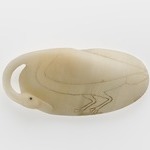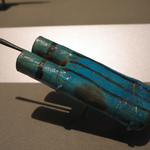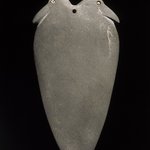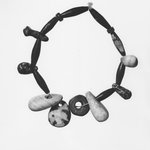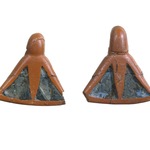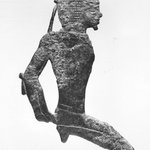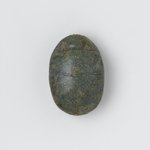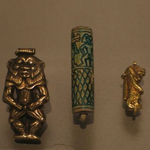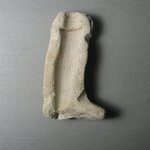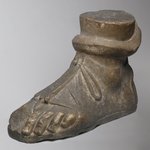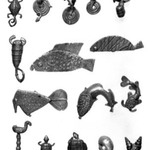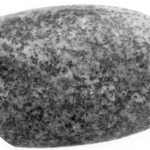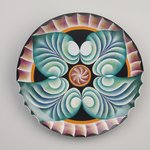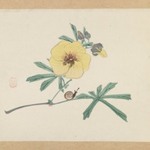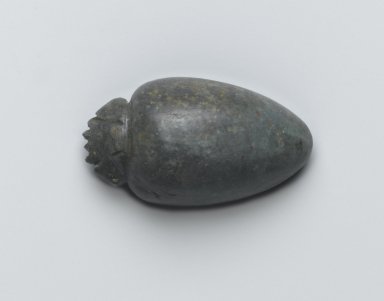

Heart Amulet with Head of a Scarab, ca. 1539–1190 B.C.E. Jade (probably), 9/16 x 1 1/16 x 1 7/8 in. (1.5 x 2.7 x 4.8 cm). Brooklyn Museum, Charles Edwin Wilbour Fund, 37.492E. Creative Commons-BY (Photo: Brooklyn Museum, 37.492E_top_PS2.jpg)

Heart Amulet with Head of a Scarab, ca. 1539–1190 B.C.E. Jade (probably), 9/16 x 1 1/16 x 1 7/8 in. (1.5 x 2.7 x 4.8 cm). Brooklyn Museum, Charles Edwin Wilbour Fund, 37.492E. Creative Commons-BY (Photo: Brooklyn Museum, 37.492E_bottom_PS2.jpg)

Heart Amulet with Head of a Scarab, ca. 1539–1190 B.C.E. Jade (probably), 9/16 x 1 1/16 x 1 7/8 in. (1.5 x 2.7 x 4.8 cm). Brooklyn Museum, Charles Edwin Wilbour Fund, 37.492E. Creative Commons-BY (Photo: Brooklyn Museum, CUR.37.492E_in_situ.jpg)

Heart Amulet with Head of a Scarab, ca. 1539–1190 B.C.E. Jade (probably), 9/16 x 1 1/16 x 1 7/8 in. (1.5 x 2.7 x 4.8 cm). Brooklyn Museum, Charles Edwin Wilbour Fund, 37.492E. Creative Commons-BY (Photo: Brooklyn Museum, CUR.37.492E_view01.jpg)
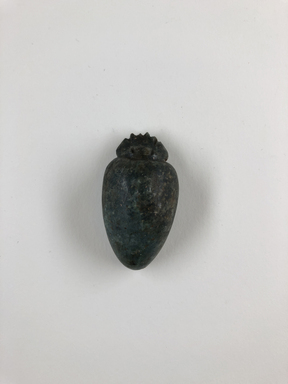
Heart Amulet with Head of a Scarab, ca. 1539–1190 B.C.E. Jade (probably), 9/16 x 1 1/16 x 1 7/8 in. (1.5 x 2.7 x 4.8 cm). Brooklyn Museum, Charles Edwin Wilbour Fund, 37.492E. Creative Commons-BY (Photo: Brooklyn Museum, CUR.37.492E_view02.jpg)

Heart Amulet with Head of a Scarab, ca. 1539–1190 B.C.E. Jade (probably), 9/16 x 1 1/16 x 1 7/8 in. (1.5 x 2.7 x 4.8 cm). Brooklyn Museum, Charles Edwin Wilbour Fund, 37.492E. Creative Commons-BY (Photo: Brooklyn Museum, CUR.37.492E_view03.jpg)

Heart Amulet with Head of a Scarab, ca. 1539–1190 B.C.E. Jade (probably), 9/16 x 1 1/16 x 1 7/8 in. (1.5 x 2.7 x 4.8 cm). Brooklyn Museum, Charles Edwin Wilbour Fund, 37.492E. Creative Commons-BY (Photo: Brooklyn Museum, CUR.37.492E_view04.jpg)

Heart Amulet with Head of a Scarab, ca. 1539–1190 B.C.E. Jade (probably), 9/16 x 1 1/16 x 1 7/8 in. (1.5 x 2.7 x 4.8 cm). Brooklyn Museum, Charles Edwin Wilbour Fund, 37.492E. Creative Commons-BY (Photo: Brooklyn Museum, CUR.37.492E_view05.jpg)

Heart Amulet with Head of a Scarab, ca. 1539–1190 B.C.E. Jade (probably), 9/16 x 1 1/16 x 1 7/8 in. (1.5 x 2.7 x 4.8 cm). Brooklyn Museum, Charles Edwin Wilbour Fund, 37.492E. Creative Commons-BY (Photo: Brooklyn Museum, CUR.37.492E_view06.jpg)

Heart Amulet with Head of a Scarab, ca. 1539–1190 B.C.E. Jade (probably), 9/16 x 1 1/16 x 1 7/8 in. (1.5 x 2.7 x 4.8 cm). Brooklyn Museum, Charles Edwin Wilbour Fund, 37.492E. Creative Commons-BY (Photo: Brooklyn Museum, 37.479E_37.480E_37.492E_GrpA_SL4.jpg)

Heart Amulet with Head of a Scarab, ca. 1539–1190 B.C.E. Jade (probably), 9/16 x 1 1/16 x 1 7/8 in. (1.5 x 2.7 x 4.8 cm). Brooklyn Museum, Charles Edwin Wilbour Fund, 37.492E. Creative Commons-BY (Photo: Brooklyn Museum, CUR.37.492E_NegA_bw.jpg)
Heart Amulet with Head of a Scarab
Egyptian, Classical, Ancient Near Eastern Art
The unusual shape of this amulet represents an animal’s heart—the shape of the hieroglyph for “heart”—with the head of a scarab beetle, a symbol of regeneration.






